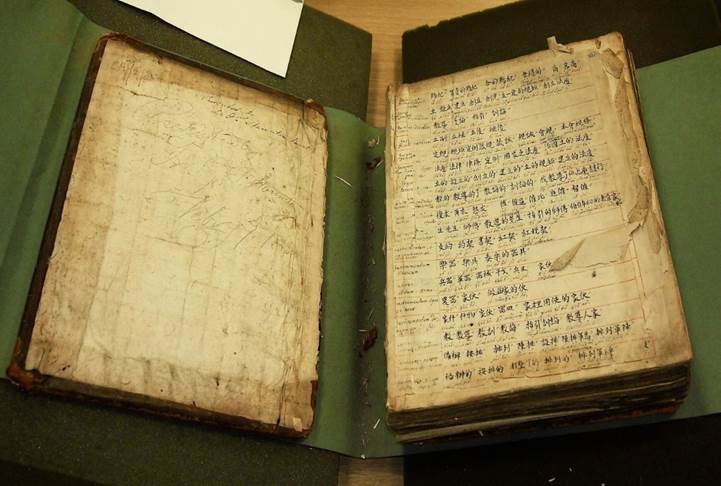Conservation of Latin-Chinese manuscript dictionary: a progress report
Over the course of the year, a team of conservators has been working hard at the Society to conserve a rare 1745 Latin-Chinese dictionary. This project was funded thanks to generous support from the National Manuscripts Conservation Trust and the Sino-British Fellowship Trust. Conservation of the two-volume manuscript has gone well and is now drawing towards completion. Most of the paper repairs and re-binding of the volumes has been finished. The main outstanding tasks are the creation of custom boxes to contain the manuscripts, as well as custom book cradles to support the manuscripts when they are opened for use. Once this has been done, both volumes will be thoroughly checked for any remaining damage, and any final repairs will be carried out.


The dictionary was donated in 1824 by one of the founders of the RAS, Sir George Staunton. It is a rare and early example of a Latin-Chinese dictionary and one of the most important parts of the Society’s Chinese holdings. The dictionaries were originally created as working volumes by Catholic missionaries in Beijing, used to assist ongoing translation work from the mid-eighteenth century onwards, and were clearly well-used. Today, they are of interest to researchers particularly as a record of how Europeans understood the Chinese language at the time, as well as being an important part of the documentary history of Chinese-European cultural interaction.
The volumes experienced a great deal of wear and tear in the eighteenth century and there is extensive evidence of historical repair work which aimed to reinforce the pages by adding strips of paper along the edges. Unfortunately, over time the added strips of paper created a sharp edge along which the pages have split, and continue to do so, resulting in knife-like cuts to the page. One of the main goals of the conservation project has been to painstakingly repair these cuts and cracks on each of the manuscript’s 1200 pages.

In order to carry out appropriate conservation work it is necessary to understand the nature of the paper used in the manuscripts. Paper production originated in China over 2000 years ago, and spread west through Asia into Europe via the Silk Road. Over the centuries a number of techniques have been used to create paper and paper-like materials in China, resulting in a number of different varieties of paper; and conservation of different types of paper brings different challenges.
The type of Chinese pith paper used in the production of this manuscript dictionary presents a number of conservation problems. This paper is very sensitive to moisture, with a tendency to expand and contract, and is also very brittle. This means that mechanical damage is likely if the paper is not able to move freely, as in the case of a bound volume. Similarly, if it is torn, or as it degrades naturally over time, it becomes more prone to cracking or tearing along the grain of the paper. The paper can easily be damaged by the lightest pressure from a finger or sharp object. Great care must be taken not to crush the page and it is important to avoid excess handling.
Fortunately, the conservation project has stabilized and repaired the manuscript and will enable researchers to consult it; but it is still a fragile document. We have carried out a full digitization of the manuscript and this digital version will not only help preserve the contents of the manuscript but will also make it easier for international users to gain access to it.
The final stages of the conservation will be finished by the end of this year. We look forward to announcing the completion of the project and also to welcoming researchers to the Library to consult this important manuscript.
Parts of this blog post were borrowed with permission from a presentation given by conservator David Jacobs before the Society’s AGM earlier this year.



